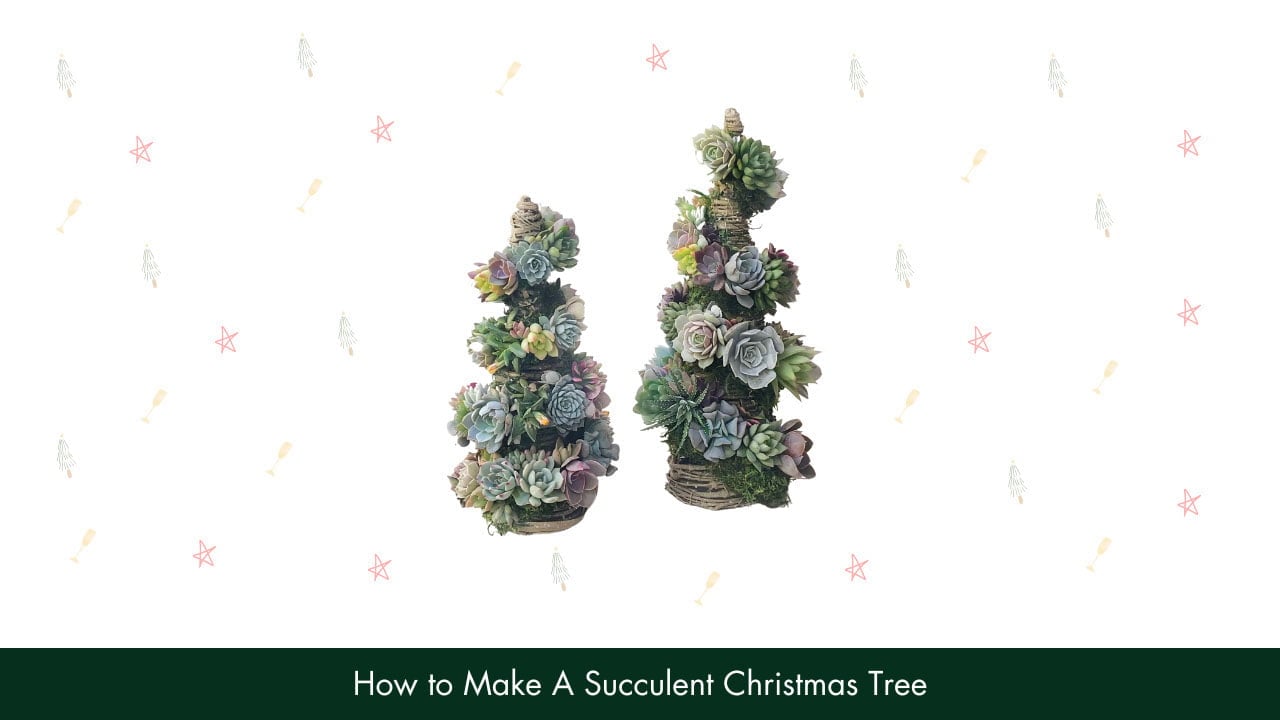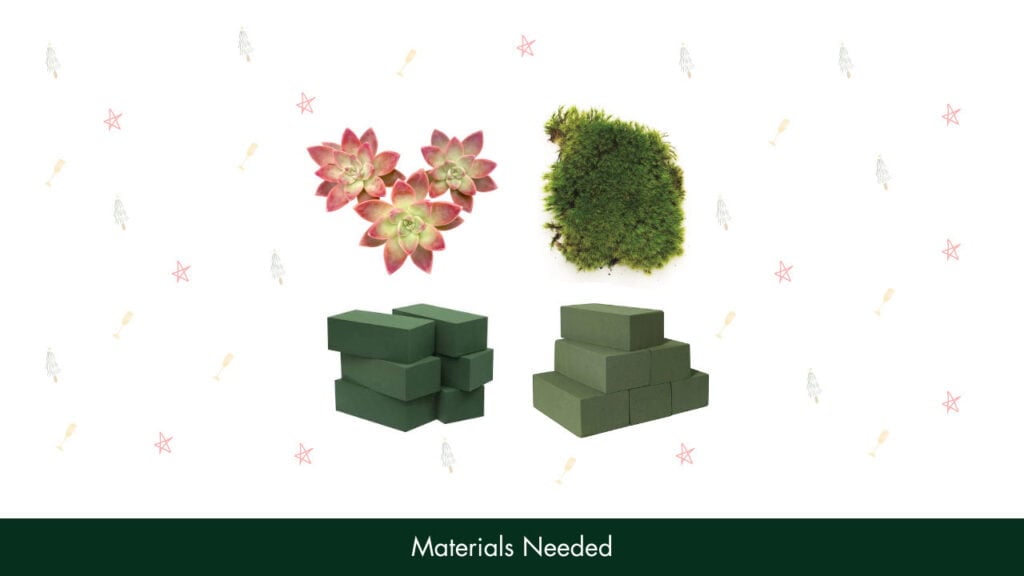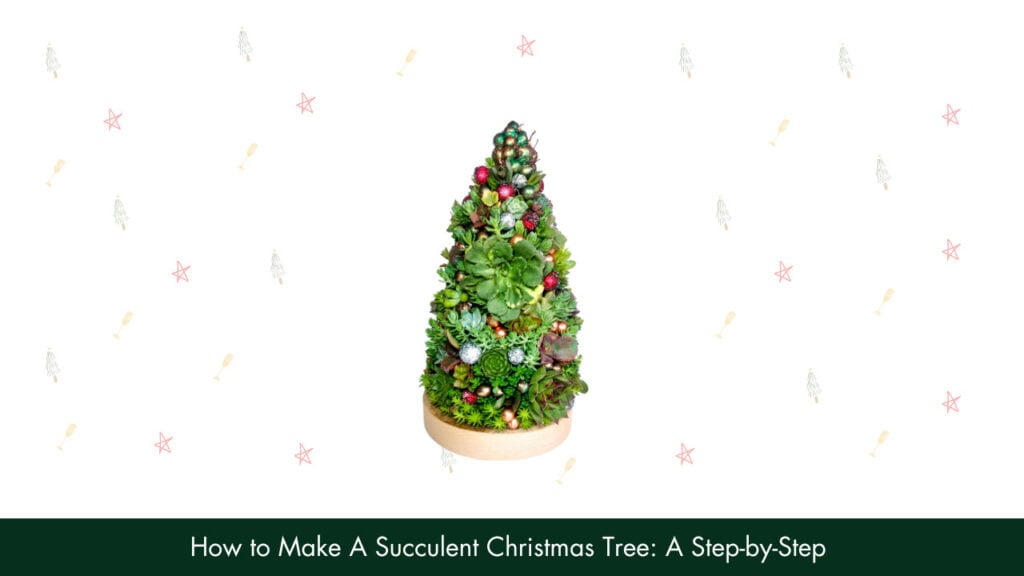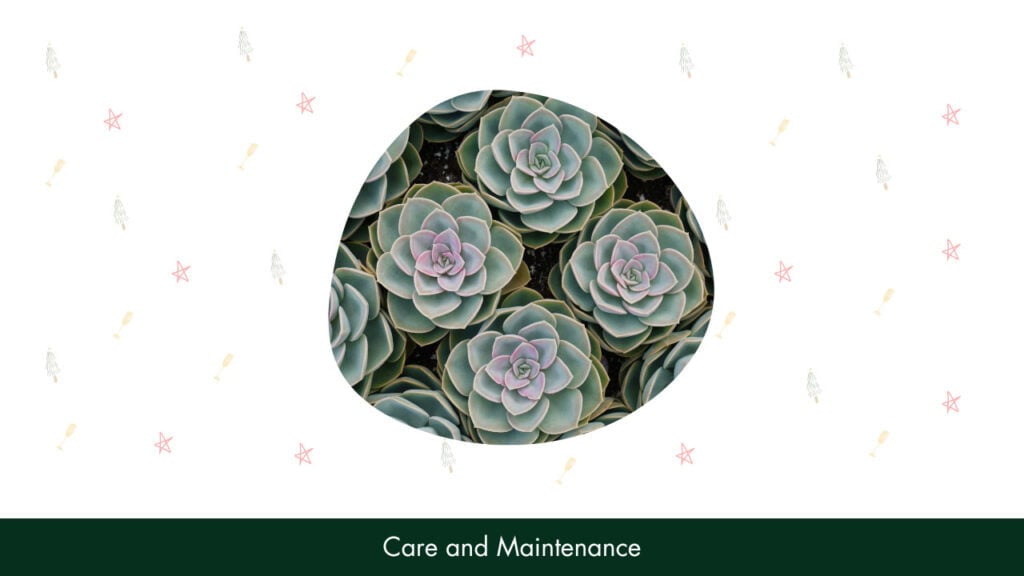A succulent Christmas tree is a unique and sustainable alternative for a tiny home and apartment since it can be conveniently placed on the centerpiece or table. All you need to do is create a tree form out of chicken wire, floral foam, and geotextile fabric and insert succulent cuttings in it.

Decorating a regular Christmas tree with ornaments is exciting, but having a living tree form with undulating shapes and pastel colors will spruce up your centerpiece, unlike standard pine trees. In recent years, more and more people are shifting towards eco-friendly and sustainable ways to celebrate the festive season, so using artificial trees is gaining popularity.
However, unlike purchasing a real pine tree, creating a DIY succulent Christmas tree is an eco-friendly, low-maintenance option that will live for a long time. And you won’t need to clean the pine needles scattered around in your room!
Made from succulent cuttings and floral foam, it will add substantial texture and vibrancy to your holiday table. So, we’ll guide you through the step-by-step process of making a cone-shaped succulent tree.
Read on!
How To Make A Succulent Christmas Tree

Materials Needed
1. Wet Floral Foam
Purchase a nine or 12 inches floral foam cone from Amazon or a local florist. We recommend buying the 12-inch one since you can always trim the excess with a serrated knife.
Tip
You can get the excess floral foam covered with a small tree topper or collar, which covers up to three inches of foam.
2. Soaked Floral Foam
You can create this with either dry or wet floral foam, but the latter is easier to manage. However, Sphagnum moss and succulents are low-maintenance and don’t need too much water. Excess water can damage the roots and help mold thrive on its stems, so you must be careful about how much you’re soaking the foam.
Fill up a sink and place the cone foam in there - don’t push or press it too hard to avoid it getting waterlogged. Place this soaked foam on a plate to catch excess water while you work on your succulent plants. You can also put it on the display base for your succulent tree.
Warning: Don't water your succulent tree if you use wet floral foam. You can occasionally water it if you’ve used dry foam.
3. Succulent Cuttings
To create the perfect Christmas tree out of succulent plants, you’ll need at least 30 succulent cuttings to create a 9-inch tree. But you must remember you need not necessarily buy 30 plants individually since many cuttings can come out of one succulent plant. So, order around 20 succulent plants in bulk and ensure they come in a sturdy succulent box.
Then, separate the plants into various cuttings - small succulents and larger succulents and leave as much stem as possible while trimming. Then, insert a toothpick into the plant stem to make it easier for them to attach to the pot or planter.
4. Moss
Adding moss to the base of your succulent tree prevents the bottom leaves from touching the soaked foam, which can potentially lead to mold. Typically, sphagnum moss is most convenient for covering spots where the floral foam is showing. But sphagnum moss can be pretty expensive, so you can also use sheet moss for this process.
5. Other Items
Besides the above materials, you’ll require these tools to prepare and display the succulent tree:
- Chicken wire
- Wire cutter
- Potting soil
- Bucket or large bowl
- Rosette shaped succulents
- Wire tree form
- Geotextile fabric
- Ornaments

How to Make A Succulent Christmas Tree: A Step-by-Step Guide
Succulent plants are very sturdy, so you can create a unique Christmas tree with varied styles and colors, fitting perfectly into our collection of themed Christmas tree ideas. Some people prefer an upside-down Christmas tree to add quirkiness to their living room, and you can create that with succulent cuttings on a planter. Here, we’ll walk you through a simple guide to making an upright succulent tree this holiday season.
1. Soak The Sphagnum Moss
Presoak the sphagnum moss in a bucket full of water for at least 15 minutes, and while it’s soaking, gather the other supplies and fill the pot with potting mix. Ensure the base of the planter is bigger than the wire tree form so that there’s enough space for smaller succulents at the bottom.
Once the sphagnum moss is fully soaked, gently press it to squeeze out any excess water and set it aside.
2. Prepare the Tree Form
Using a wire cutter, cut the chicken wire into a triangle with two equal sides (isosceles). As discussed, the base of the triangle should be smaller than that of the planter, and the height can be according to your preference. Though usually, it’s best to stick to making a nine-inch one.
Next, shape the chicken wire into a cone - bring the long ends together and wrap the cut ends of the wire onto each other to create a seam. We recommend wearing protective gloves and using pliers during the process.
Moving on, cut a piece of the textile and ensure it’s big enough to fit inside the tree foam so there’s no spot uncovered. If there’s excess geotextile fabric coming out of the tree form, trim it with a pair of scissors.
Then, fill the lined form with the presoaked moss, ensuring every inch of it is filled, including the top part of the cone shape. Next, gently press the soil mix into the tree and fill in the gaps between the sphagnum moss.
3. Adding the Succulent Cuttings
Easily pull the cuttings from the succulents box and shake off the excess soil. Then, starting with the bigger succulents, poke a hole or cut a slit into the fabric and carefully insert each stem. Work your way up with larger succulents on the bottom and smaller ones on top. Ensure you avoid the chicken wire (the material of the tree form) while inserting the cuttings to avoid breaking them.
Remember to insert the cuttings deep so the fabric starts right below the bottom leaves.
Tip
If the slit is too big for the teardrop and rosette-shaped succulents, fill the hole with the soaked moss and ensure it’s sitting tight.
4. Give Your Tree Some Texture And Dimension
Once you’ve inserted all the cuttings into your succulent Christmas tree, fill in any visible gaps with sphagnum moss until you can’t see any foam. Adding differing succulent shapes and green hues not only gives your succulent tree more dimension but also connects it to the diverse forms found in nature and wildlife trees, enhancing its natural appeal. You can also add cacti to your planter to add more texture - use hot glue if it’s difficult to secure the cacti into the foam.
5. Add Ornaments
Once you’re done, step back and view your succulent tree from all angles to check if it’s well-balanced and full. Make adjustments and add moss wherever needed. If you’re happy with the results, add some Christmas decorations, such as baubles, bells, evergreen sprigs, bows, string lights, and even a star top using flower pins.

Care and Maintenance
Succulents are very low-maintenance and don’t require frequent watering, but they do appreciate some sunlight. Remember to keep your succulent tree in a sunny area and regularly rotate it so that each cutting gets enough light.
But you might find that some of the cuttings have mold at the end of the holiday season since you’re using wet foam. You can prevent this by using dry foam instead, but it’s much harder to work with. Use hot glue to secure the cuttings in place if you can’t secure them on the dry foam.
Moreover, ensure you take off all ornaments after the celebrations are over so you don’t put extra pressure on the Christmas tree. If you find pests on your succulents, dab some pesticide on the base of each stem using a cotton bud. And check the moisture level of the potting mix every week to see if it needs water.
If you want to spruce up your home décor after the season passes, add the tree to a succulent garden or terrarium - and enjoy it all year!
How do I choose the right succulent plants for my Christmas tree?
There isn’t any ‘right’ succulent for making a Christmas tree, but getting as many varieties of succulents as possible is preferred to create a unique ensemble. We recommend purchasing fleshier, bigger succulents with strong, fat stems, such as echeverias, since they can live for months in foam without developing mold.
This doesn’t mean you shouldn’t purchase smaller, dainty succulents since they’re great for filling in the gaps and creating texture. Just make sure they are in good condition and the parent plant has strong roots.
How do I assemble my succulent Christmas tree?
Prepare a tree form using chicken wire by cutting out an isosceles triangle and rolling it into a cone shape. Then lay the geotextile fabric on the inside and fill it with potting soil. Next, poke some holes into the fabric and gently insert each succulent stem until the tree form is completely covered.
Then, add moss to fill in the gaps and decorate the succulent Christmas tree with ornaments - and you’re good to go!
Can I use a fake tree to make a succulent Christmas tree?
Technically, you can insert fake Christmas tree stems among the succulent plants, but we don’t recommend it. Not only will this ruin the entire live plant aesthetic, but it will also disrupt the texture and hue of the tree.
Moreover, the fake tree can entangle with any root formation, if any, thus disrupting the healthy growth of your succulent stems. If you want to put a fake tree on the centerpiece, it’s better to stick to fake Christmas décor and not mix it with living plants.
Can I reuse my succulent Christmas tree next year?
Usually, a succulent tree lasts for a few months, but there’s a way you can recycle the cuttings, if not the entire tree, next year. But it might not be possible if you’re giving someone this Christmas tree as a gift.
When the holiday season is over, dismantle your succulent tree and gently remove each cutting. It’s a great sign if you see roots forming - this means they’ve grown into a plant when repotted.
When you’re done dismantling it, plant them in a big planter or your succulent garden and place them in a well-lit area. Ensure you discard the ones with mold or root rot. This process will help you have enough succulents to create a new Christmas tree next year!
How many succulents do you need to create a tree?
Generally speaking, the number of succulents you need will depend on the size you want the Christmas tree to be. In this Do It Yourself tutorial, we’ve recommended using 20-30 succulents for a nine-inch Christmas tree. But you can use more or less, depending on how many cuttings you can harvest from a single plant.
How to take care of a succulent Christmas tree?
Succulents can last for a long time indoors if you keep them in the right conditions. They require a lot of direct sunlight and don’t like being too wet. Drench the entire potting mix with water, and don’t water it again unless it is completely dried out.
To Sum It Up
Making a succulent Christmas tree is a more eco-friendly option for your holidays since you can plant it in soil and grow it into individual plants when the celebration is over. Moreover, they are easier to care for than traditional pine or fir trees, and they make less of a mess - so you won’t have to clean up scattered pine needles!
Even though creating a succulent tree takes more time and effort than placing a dismantled pine tree in your living room, one cannot deny that it offers a unique aesthetic. Plus, you can create different styles with these succulent stems, including an upside-down tree.
That being said, we’ve reached the end of our step-by-step guide on how to make a succulent Christmas tree. If you want more content related to Christmas décor, keep an eye out for us.
See you next time!
